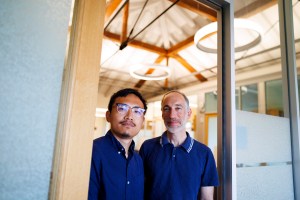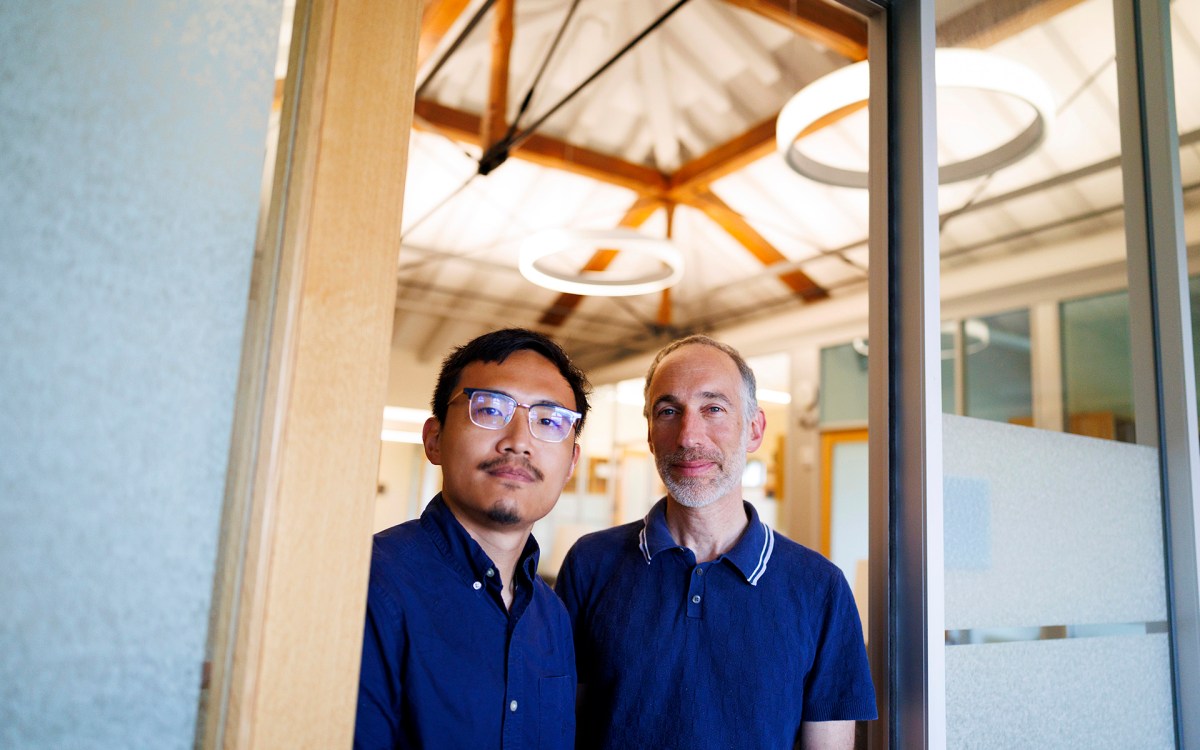Five faculty members named young innovators by Technology Review
Stem cells, photosynthesis research earn mention
Work on flying robots, surgical tape modeled on gecko feet, energy tips gleaned from plants, new ways to grow stem cells, and dramatically smaller medical imaging equipment has landed five Harvard faculty members on a list of the world’s top 35 young innovators.
The annual list is compiled by Technology Review magazine and features what the editors and a panel of judges see as the 35 top innovators in business and technology who are under the age of 35.
The list, called the TR35, includes Assistant Professor of Chemistry and Chemical Biology Theodore Betley, John L. Loeb Associate Professor of the Natural Sciences Donhee Ham, Assistant Professor of Stem Cell and Regenerative Biology Konrad Hochedlinger, Instructor in Medicine Jeffrey Karp, and Assistant Professor of Electrical Engineering Robert J. Wood.
Winners will be honored at the EmTech08 Conference, held Sept. 23-25 at the Massachusetts Institute of Technology (MIT).
“Discovering the amazing young men and women who make up the TR35 is one of the highlights of the year for us,” said Jason Pontin, editor in chief and publisher of Technology Review, an independent magazine owned by MIT. “The innovators on our 2008 list have made truly remarkable and valuable contributions.”
Learning from leaves
Betley considers himself a simple chemist trying to figure out one of nature’s most valuable secrets: how plants generate energy from sunlight.
Although it has long been known that plants use the sun’s light and the process of photosynthesis to change water and carbon dioxide into sugar, water, and oxygen, the exact mechanism is not yet completely understood.
Betley, who came to Harvard in 2007, is seeking molecules and methods that use as little energy as possible while mirroring the natural processes that break water into hydrogen and oxygen. Although scientists can already break water molecules into their component gases, it takes too much energy to make the process — and the hydrogen gas that results — a reliable energy source.
“It’s really an exciting time because everyone is paying attention to the energy crisis,” Betley said.
Advancing stem cell science
Hochedlinger, of the Harvard Stem Cell Institute, Massachusetts General Hospital (MGH), and Harvard’s Department of Stem Cell and Regenerative Biology, has two major research thrusts. He is seeking to understand how cells can be reprogrammed and is also searching for ways to make the reprogramming safer, a necessary step before any resulting therapies can be used in people.
He has been working at the cutting edge of stem cell science where his most recent discoveries advance our understanding of how to turn back the clock on adult tissue cells so they have the vast development potential of embryonic stem cells — without the ethical issues surrounding embryonic stem cell research.
Though stem cell and regenerative science have seen several major advances in recent years, the use of viruses in the process of reprogramming cells remains a hurdle, Hochedlinger said, as they raise the specter of infection in humans. The viruses are used to inject genes for various transcription factors into subject cells. The transcription factors turn an adult cell, a skin cell, for example, into a cell with the potential to develop into any cell type in the body. Such cells are called induced pluripotent cells.
“There are many open questions [in stem cell science],” Hochedlinger said. “Almost anything you do, you get an interesting result.”
Learning from the gecko master
Small lizards called geckos are masters of wall climbing. So when Karp, of the Harvard-MIT Division of Health Sciences and Technology and of Brigham and Women’s Hospital, and colleagues were looking for a new medical adhesive, geckos were a natural inspiration.
Karp developed a waterproof adhesive bandage that features the same types of tiny hills and valleys that cover a gecko’s feet and allow it to cling to walls and ceilings. The bandage, which includes a glue that helps it stick to wet surfaces, is biodegradeable, so it can be left in place after surgery, providing a needed alternative to sutures and staples.
“It’s such a great honor, particularly given the quality of the people who have previously been named to the TR35,” Karp said. “I must also recognize my wonderful collaborators, without which this work would not have been possible and with whom I would like to share this award.”
Making imaging portable
Ham was recognized for his role in building one of the smallest complete nuclear magnetic resonance (NMR) systems yet. In work with collaborators at MGH and Harvard Medical School, Ham created an NMR system that weighs just 4.4 pounds and is able to scan biological samples using magnetic nanoparticles. It is 60 times more sensitive than a commercial machine, which weighs hundreds of pounds, and so is potentially useful in such critical applications as battlefields.
Flying robots
Wood was honored for his advances in creating a life-sized robotic fly. Wood’s research not only determined the optimal wing design and function, but also overcame a host of production hurdles, forming the needed articulated joints and rigid exoskeletons by using lasers and composite materials.
Wood’s robotic fly is believed to be the first to mimic a natural fly’s size and mechanics to take off on its own. Wood says that similar small, flying robots could be used in the future in surveillance or detection scenarios in dangerous or hard-to-reach locations.
“Both of these guys [Ham and Wood] are fearless,” said Greg Morrisett, Allen B. Cutting Professor of Computer Science and associate dean for computer science and engineering at Harvard’s School of Engineering and Applied Sciences. “What they aim for is nothing less than turning science fiction into reality. They are willing to pick up and master whole new fields, from materials to biology, to reach their goals.”





